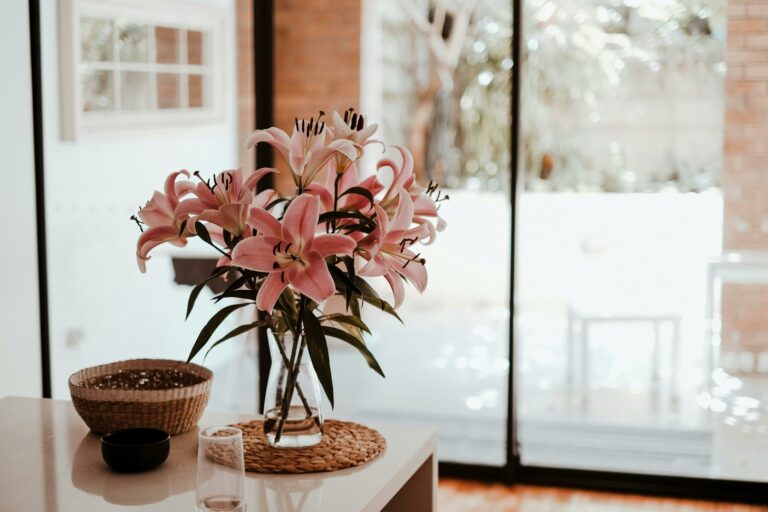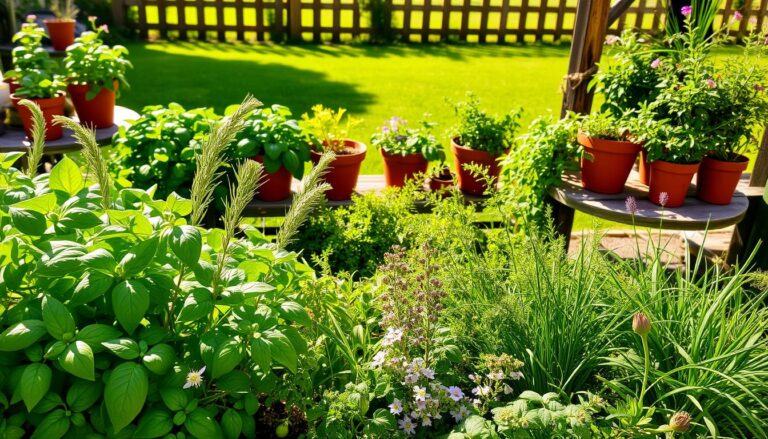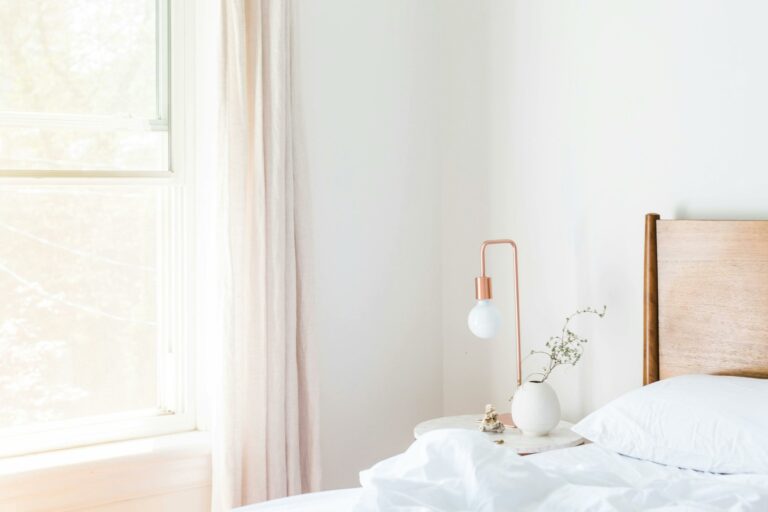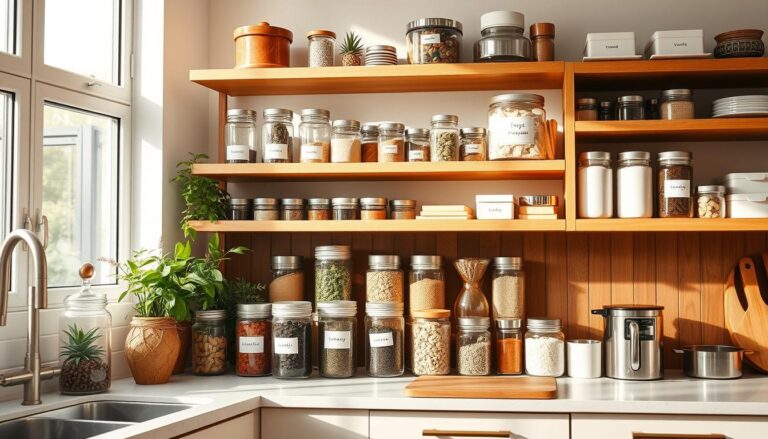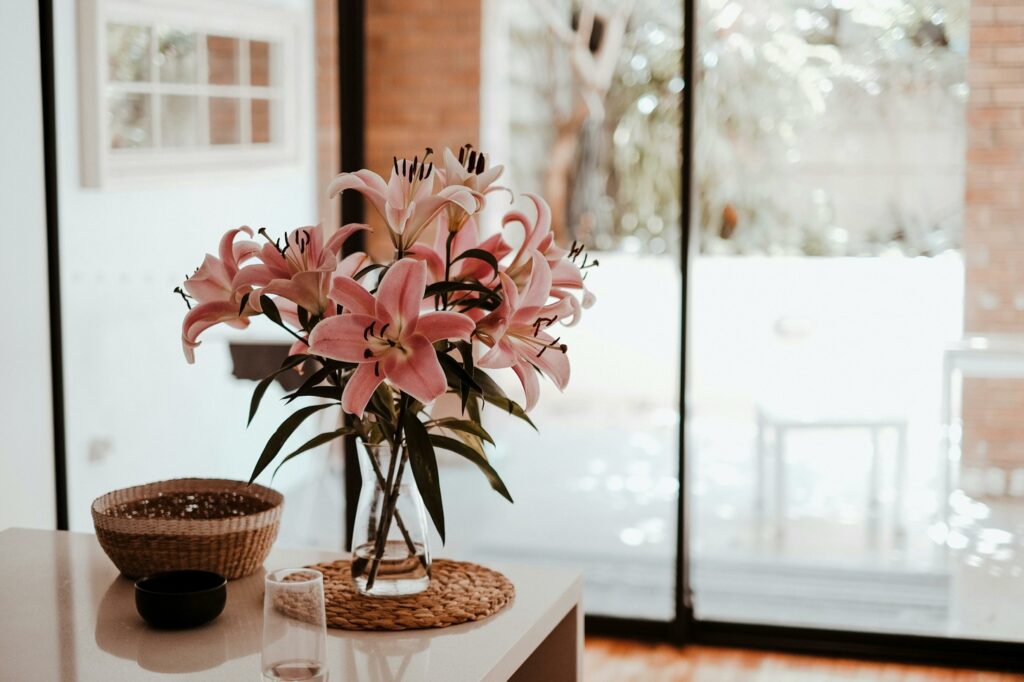
Are you tired of watching your houseplants wither away despite your best efforts? You’re not alone. Many of us struggle to keep our indoor plants thriving. Houseplant care can seem daunting, but with the right guidance, it can become a rewarding hobby.
Caring for houseplants not only purifies the air but also adds a touch of nature to our living spaces. As we explore the world of indoor gardening, we’ll cover the essential tips and tricks to help you get started on your journey to becoming a successful houseplant parent.
Key Takeaways
- Understanding the basics of houseplant care
- Choosing the right plants for your indoor space
- Essential tips for watering and maintaining your plants
- Common mistakes to avoid in houseplant care
- Creating a nurturing environment for your plants to thrive
Why Houseplants Deserve a Place in Your Home
Incorporating houseplants into your home can have a significant impact on both your physical and mental well-being. Houseplants are known to purify the air, reduce stress, and boost mood, making them a valuable addition to any indoor space.
Physical and Mental Health Benefits
Houseplants have been shown to improve indoor air quality by removing pollutants and toxins, thus contributing to better physical health. They also have a positive impact on mental health by reducing anxiety and stress levels.
- Air purification
- Stress reduction
- Mood enhancement
Aesthetic Value and Interior Design Impact
Houseplants can significantly enhance the aesthetic appeal of a room, adding a touch of nature and beauty to your decor. They come in a variety of shapes, sizes, and colors, making it easy to find the perfect plant to complement your interior design.
Building a Connection with Nature Indoors
Caring for houseplants allows you to build a connection with nature from the comfort of your own home. This connection can be particularly beneficial for those living in urban areas or with limited access to outdoor green spaces.
Choosing the Right Plants for Beginners
The journey to becoming a skilled plant parent starts with choosing the right plants, and we’re here to guide you through it. As beginners, it’s essential to start with plants that are not only beautiful but also easy to care for.
Top 5 Nearly Indestructible Houseplants
For those new to indoor gardening, certain plants stand out for their hardiness and low-maintenance requirements. Here are the top 5 nearly indestructible houseplants perfect for beginners:
Snake Plants (Sansevieria)
Snake Plants are known for their ability to thrive in low-light conditions and infrequent watering, making them perfect for busy individuals.
Pothos (Epipremnum aureum)
Pothos is a versatile, low-maintenance plant that can grow in various lighting conditions and can survive with neglect from time to time.
ZZ Plants (Zamioculcas zamiifolia)
The ZZ Plant is a low-water plant that can tolerate a range of lighting conditions, making it ideal for indoor spaces with limited natural light.
Spider Plants (Chlorophytum comosum)
Spider Plants are easy to care for and produce cute white flowers. They’re also great air purifiers, making them a popular choice for indoor gardens.
Peace Lilies (Spathiphyllum)
Peace Lilies are known for their elegant white blooms and ability to purify the air. They prefer well-draining soil and moderate watering.
Matching Plants to Your Living Conditions
When choosing houseplants, it’s crucial to consider your living conditions, including light exposure and temperature. Some plants thrive in bright, direct light, while others prefer shade or indirect light.
| Plant | Light Preference | Watering Needs |
|---|---|---|
| Snake Plant | Low to Bright Light | Infrequent Watering |
| Pothos | Low to Bright Light | Moderate Watering |
| ZZ Plant | Low to Medium Light | Low Watering |
| Spider Plant | Bright Indirect Light | Moderate Watering |
| Peace Lily | Medium to Bright Light | Moderate Watering |
Where to Purchase Healthy Specimens
To ensure you’re getting healthy plants, consider purchasing from local nurseries or reputable online plant retailers. These sources typically provide well-cared-for plants and valuable advice on plant care.
Essential Tools and Supplies for Indoor Gardening
To create a thriving indoor garden, we must first gather the necessary equipment and materials. Indoor gardening for beginners requires a thoughtful approach to selecting the right tools and supplies.
Must-Have Equipment for Plant Care
Having the right tools is crucial for the health and well-being of our plants. Let’s start with the basics.
Watering Tools
Watering is one of the most critical aspects of plant care. We recommend using a watering can with a long spout to reach all areas of the plant without causing damage. Additionally, a moisture meter can be invaluable in determining when our plants need water, helping us avoid both overwatering and underwatering.
Pruning and Maintenance Tools
Regular pruning is essential for maintaining the shape and health of our plants. Pruning scissors or shears are must-haves for this task. For larger plants, loppers may also be necessary.
Understanding Potting Media
The potting mix is the soil in which our plants’ roots grow. A good potting mix should retain moisture but also drain excess water to prevent root rot. We should look for a mix that is designed for indoor plants and contains ingredients like peat moss or coconut coir for moisture retention.
Container Selection and Drainage Considerations
Choosing the right container is vital for our plants’ health. Containers should have drainage holes to prevent waterlogged soil. The material of the container can also impact plant health; for example, terracotta pots are breathable and can help prevent overwatering.
Understanding Plant Light Requirements
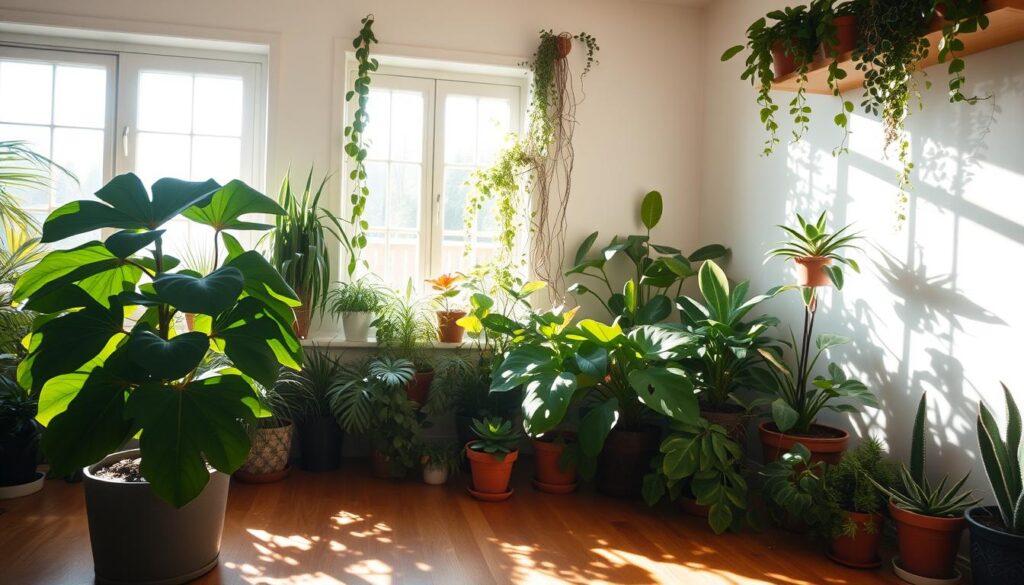
Light is one of the most critical factors in houseplant care, and getting it right can make all the difference. The right amount and type of light can significantly impact the health and well-being of your indoor plants.
Decoding Light Levels in Your Home
To provide your plants with the right light, you first need to understand the light levels in your home. This involves distinguishing between direct and indirect light.
Direct vs. Indirect Light Explained
Direct light comes straight from the sun and is typically found in south-facing windows. It’s intense and can be too much for some plants. Indirect light, on the other hand, is filtered or diffused, often found in east- or west-facing windows. It’s gentler and suitable for most houseplants.
For a more precise measurement, you can use light meters or apps designed to measure light intensity. These tools help you determine if your plants are receiving the right amount of light.
Signs Your Plant Is Getting Improper Light
If your plant is not getting the right light, it will show signs such as leggy growth or yellowing leaves. Recognizing these signs early can help you adjust the lighting conditions.
Supplemental Lighting Options
For plants that need a little extra light, supplemental lighting options like LED grow lights can be a great solution. These lights are energy-efficient and can be adjusted to provide the specific spectrum and intensity your plants need.
The Beginner's Guide to Caring for Houseplants: Watering Techniques
Watering is a crucial aspect of houseplant care that can make or break the health of your indoor garden. Proper watering techniques are essential for keeping houseplants alive and thriving.
How to Determine When Plants Need Water
Determining when your houseplants need water is a critical skill that can take some practice. There are several methods to check soil moisture.
The Finger Test Method
One simple way to check if your plant needs water is by using the finger test. Insert your finger into the soil up to the first knuckle. If the soil feels dry, it’s time to water. If it’s already moist, wait a few more days.
Weight Assessment Technique
Another method is to lift the pot and assess its weight. A dry pot will be significantly lighter than a watered one. This technique requires getting to know the weight of your pot when it’s dry and when it’s watered.
Moisture Meters and Technology
For a more precise measurement, consider using a moisture meter. These devices can give you an accurate reading of the soil’s moisture level, taking the guesswork out of watering.
Different Watering Methods Explained
There are various ways to water your houseplants, including top watering, bottom watering, and self-watering systems. The best method depends on the type of plant, its size, and the soil mix.
- Top watering is the most common method, where water is poured directly onto the soil.
- Bottom watering involves placing the pot in a tray of water, allowing the soil to absorb moisture from the bottom.
- Self-watering systems are ideal for busy people, as they provide a steady supply of water to the plant.
Avoiding Overwatering and Underwatering
Both overwatering and underwatering can be detrimental to your houseplants. Overwatering can lead to root rot, while underwatering can cause stress and leaf drop. By understanding your plant’s watering needs and using the right techniques, you can avoid these common pitfalls.
By mastering the art of watering houseplants, you’ll be well on your way to becoming a successful plant parent.
Temperature and Humidity Essentials
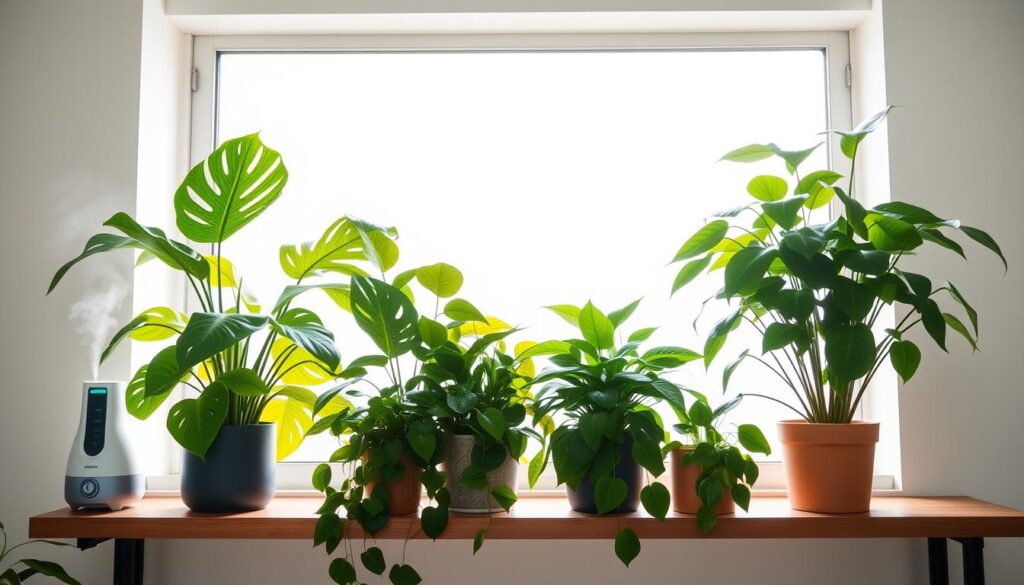
Maintaining the right temperature and humidity levels is crucial for the health and well-being of your houseplants. Most houseplants thrive in temperatures between 65°F to 75°F (18°C to 24°C), which is typical for average indoor conditions.
Ideal Temperature Ranges for Common Houseplants
Different plants have different temperature preferences. For example, plants like African Violets and Begonias prefer the cooler end of this range, while plants like Snake Plants and Spider Plants can tolerate a wider temperature range.
Increasing Humidity for Tropical Plants
Tropical plants require higher humidity levels. To achieve this, you can use humidifiers or pebble trays filled with water. As the water evaporates, it increases the surrounding humidity.
Humidifiers and Pebble Trays
Humidifiers are a straightforward solution, while pebble trays are a more DIY-friendly option. Simply place the pot on the tray, ensuring it’s not sitting in water.
Grouping Plants for Humidity
Another method is to group plants together, creating a microclimate that retains moisture.
Protecting Plants from Environmental Stress
Keep your plants away from drafts, radiators, and extreme temperatures. Monitoring your plants’ responses to their environment will help you make necessary adjustments.
Feeding and Fertilizing Your Indoor Garden
To keep your indoor garden healthy, understanding how to feed your plants is essential. Houseplants require nutrients to grow and thrive, just like outdoor plants. However, their feeding needs are different due to the controlled indoor environment.
When and How to Fertilize Houseplants
Fertilizing your houseplants should be done during their growing season, typically during spring and summer. It’s crucial to choose the right fertilizer and follow the instructions on the label to avoid overfertilizing.
There are several types of fertilizers available for houseplants, including:
- Liquid fertilizers
- Slow-release options
- Organic and synthetic choices
Liquid Fertilizers
Liquid fertilizers are easy to apply and provide immediate nutrients to plants.
Slow-Release Options
Slow-release fertilizers offer a steady supply of nutrients over time, reducing the need for frequent application.
Organic vs. Synthetic Choices
Organic fertilizers are derived from natural sources, while synthetic fertilizers are manufactured. Both have their benefits and drawbacks.
Signs of Fertilizer Problems
Overfertilizing can cause damage to your plants, such as burned roots or yellowing leaves. Underfertilizing may result in slow growth or pale leaves. Monitoring your plants’ response to fertilization is key to adjusting your care routine.
Repotting and Pruning for Healthy Growth
Repotting and pruning are crucial steps in indoor gardening that ensure your plants remain healthy and thrive. As your plants grow, their needs change, and understanding when and how to repot and prune can make a significant difference in their overall health and appearance.
How to Know When It's Time to Repot
One of the key indicators that your houseplant needs repotting is when its roots start growing out of the drainage holes or the soil becomes packed and prevents proper water absorption. Another sign is when the plant’s growth slows down or appears stunted despite proper care.
Step-by-Step Repotting Process
Repotting involves several steps to minimize shock to the plant. First, choose a container that is only slightly larger than the current one.
Selecting the Right Container Size
Selecting the right size container is crucial. A pot that is too large can cause the soil to become too wet, potentially leading to root rot.
Proper Technique to Minimize Shock
To minimize shock, gently remove the plant from its pot, taking care not to damage the roots. If the roots are circling or growing out of the container, gently tease them apart with your fingers or a blunt instrument.
Strategic Pruning for Shape and Health
Pruning is not just about cutting back overgrown plants; it’s a technique to promote healthy growth and maintain the plant’s shape. By removing dead or dying leaves and stems, you encourage the plant to focus its energy on producing new, healthy growth.
| Pruning Technique | Purpose | Best Time to Prune |
|---|---|---|
| Removing dead or dying parts | Prevents disease spread | Anytime |
| Cutting back overgrown stems | Maintains shape and promotes new growth | Spring or early summer |
| Pinching off tips | Encourages branching | During active growth phase |
Propagation: Creating New Plants from Your Existing Collection
Creating new plants from our existing collection is not only cost-effective but also incredibly rewarding. As we continue to care for our houseplants, we may find that we want to share them or expand our indoor garden. Propagation is a simple and effective way to do this.
Easy Propagation Methods for Beginners
There are several methods to propagate houseplants, and we’ll explore a few that are perfect for beginners.
Water Propagation
Water propagation involves placing a cutting or leaf in a container of water until roots develop. This method is great for plants like Pothos and Philodendron.
Stem Cuttings
Stem cuttings are a popular method for propagating many houseplants. By cutting a section of stem and planting it in soil, we can encourage new growth.
Division Techniques
Division involves separating a mature plant into smaller sections, each with its own roots. This method is ideal for plants like Snake Plants and Spider Plants.
Best Plants for First-Time Propagators
Some plants are easier to propagate than others, making them perfect for beginners. Here are a few recommendations:
- Pothos: Easy to propagate in water or soil.
- Snake Plant: Can be divided or propagated through leaf cuttings.
- ZZ Plant: Can be propagated through leaf cuttings, although it’s a slower process.
Troubleshooting Propagation Problems
Even with the best care, propagation can sometimes go wrong. Here are some common issues and their solutions:
| Problem | Solution |
|---|---|
| Rotting cuttings | Reduce watering and ensure good air circulation. |
| Failure to root | Check the temperature and ensure the cutting is healthy. |
| Pests on new plants | Isolate the new plants and treat with insecticidal soap. |
By understanding these propagation methods and troubleshooting tips, we can successfully create new plants from our existing collection, expanding our indoor garden and sharing the joy of houseplants with others.
Conclusion: Growing Your Confidence as a Plant Parent
As we conclude our ultimate beginner’s guide to houseplant care, we hope you’re now equipped with the knowledge to nurture your indoor plants with confidence. By following our indoor plant care guide, you’ve learned how to choose the right plants, understand their light requirements, and master watering techniques. These houseplant care tips will help you create a thriving indoor garden that brings joy and serenity to your home.
Remember, the benefits of houseplant care extend beyond aesthetics. Our plants help purify the air, improve our mental health, and connect us with nature. As you continue on your plant parent journey, don’t be afraid to experiment and try new things. With time and practice, you’ll become more attuned to your plants’ needs, and your confidence will grow.
We encourage you to revisit our guide whenever you need a refresher on the best houseplant care practices. Happy planting, and enjoy the journey of watching your indoor garden flourish!
FAQ
How often should I water my houseplants?
The frequency of watering depends on the type of plant, its size, and the environment it’s in. We recommend checking the soil moisture by using the finger test or a moisture meter to determine when your plants need water.
What are the best houseplants for beginners?
Some of the best houseplants for beginners include Snake Plants, Pothos, ZZ Plants, Spider Plants, and Peace Lilies, as they are relatively low-maintenance and can thrive in a variety of conditions.
How much sunlight do indoor plants need?
The amount of sunlight needed varies by plant species. We recommend understanding the specific light requirements for your plants, whether it’s direct, indirect, or low light, to ensure they receive the right amount of sunlight.
How can I increase the humidity for my tropical plants?
You can increase humidity for tropical plants by using humidifiers, pebble trays, or grouping plants together to create a microclimate that retains moisture.
What is the best way to fertilize my houseplants?
The best way to fertilize your houseplants depends on the type of plant and its growth stage. We suggest using a balanced fertilizer during the growing season, and considering organic or synthetic options based on your preference.
How do I know when it’s time to repot my houseplant?
It’s time to repot your houseplant when the soil becomes packed and the plant has outgrown its container. Check for signs like slow growth, or roots growing out of the drainage holes.
Can I propagate any houseplant?
While many houseplants can be propagated, some are easier to propagate than others. We recommend starting with plants that are known to be easy to propagate, such as Pothos or Spider Plants, and using the right propagation techniques.
What are some common mistakes to avoid in houseplant care?
Common mistakes to avoid include overwatering, underwatering, and providing insufficient or excessive light. We also recommend being mindful of temperature fluctuations and fertilizing correctly to prevent damage to your plants.

